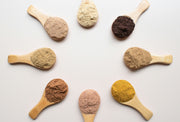
How to Exercise with Endometriosis
Endometriosis (endo) is a chronic condition characterised by painful periods, irregular menstrual cycles and infertility. Endo affects approximately 10% of reproductive aged women and can cause pelvic pain so severe that it impacts activities of daily living. Unfortunately, there’s no current cure for endo and treatment plans usually consist of medication, surgery and lifestyle changes. Endo symptoms can be debilitating, but exercise and lifestyle strategies can help to reduce inflammation and manage pain during flare-ups. In this blog, we’ll explore effective ways to exercise with endo, along with practical lifestyle changes you can implement at home to better support yourself while navigating this challenging condition.

WHAT IS ENDOMETRIOSIS?
Endometriosis is a disease which occurs when cells similar to the uterine lining grow outside of the uterus and into other areas of the female reproductive system, including the ovaries, cervix or fallopian tubes. This leads to inflammation and the formation of scar tissue throughout the pelvic region. Whilst there is no one cause of endo, it is thought to be related to the presence of excess estrogen, which increases inflammation, tissue growth and pain associated with the disease.
The main symptom of endo is pelvic pain, which may be worse during menstruation, intercourse, or when using the bathroom. Endo can also impact our fertility, the regularity of our menstrual cycles and abdominal bloating. Endo symptoms are often variable - individuals suffering from the condition may be misdiagnosed or unaware of their condition.
There is currently no cure for endo, and treatment typically involves a combination of medication, surgery and lifestyle adjustments. Contraceptive medications are commonly prescribed to help manage symptoms but are not suitable for those who are trying to conceive. Laparoscopic surgery offers a minimally invasive option to remove endometrial lesions, adhesions, and scar tissue, leading to a reduction in pain and other symptoms. Additionally, lifestyle changes such as regular exercise, dietary adjustments, and stress management can help alleviate symptoms and improving overall wellbeing.
EXERCISING WITH ENDO
Exercise may be the last thing you feel like doing when you’re suffering from endo, but studies show regular physical activity can help to reduce estrogen levels, moderate pain and increase levels of anti-inflammatory molecules in the body. Exercise also has significant benefits for our mental health, helping to reduce anxiety and depression, both of which are associated with endo.
While there are no official guidelines for exercising with endo, 30 minutes of activity per day appears to be beneficial. The type of exercise you choose is also key - research shows that the following activities can provide specific benefits for those with endo:
- Gentle aerobic exercise (such as walking, swimming, and cycling) can help reduce inflammation and manage excess estrogen levels.
- Yoga promotes strength, flexibility, and relaxation, while also helping to alleviate pain and stress associated with endometriosis.
- Pelvic floor exercises - like cat/cow stretches, pelvic tilts, glute bridges, and Pilates-inspired core work - can strengthen the pelvic muscles and improve mobility.
- Women with endo may want to be cautious when it comes to vigorous and high intensity exercise. A 2023 study found that high-impact and intense activities can exacerbate symptoms. The following exercises should be approached carefully, particularly during a flare-up:
- Jogging, running, and sprinting
- Intense cycling
- Contact sports
- High-intensity abdominal exercises (e.g. crunches)
- HIIT (High-Intensity Interval Training)
The definition of "intense" is subjective, so this doesn’t mean you should avoid these exercises forever. However, it’s crucial to listen to your body and honour its needs. During a flare-up, something as simple as 10 minutes of gentle stretching on your bed may be all you need - and that’s perfectly okay!
WHAT ELSE CAN WE DO TO HELP?
Aside from exercise, there are several other lifestyle strategies that may play a role in managing endo symptoms. The following may help to reduce inflammation, lower excess estrogen and moderate pain associated with endo:
- Minimise alcohol consumption – reducing alcohol intake can help lower excess estrogen levels, which may worsen endo symptoms.
- Avoid excess caffeine – excess caffeine may increase endo flare ups – if you notice a flare-up after a few coffees, consider switching to matcha or herbal teas as a gentler alternative.
- Increase fibre intake – a high-fibre diet supports the body in excreting excess estrogen - Naked Harvest’s THRIVE Plant Protein is a great way to add a source of fibre to smoothies and snacks!
- Stress management and relaxation – regular mindfulness practices, such as meditation, mindful walks in nature, or activities like reading, crafts, or puzzles, have been shown to reduce pain and improve overall quality of life.
- Aim for 7-8 hours of quality sleep – sleep is essential for immune function and inflammation management. Naked Harvest’s Moon Mylk range can help you unwind and prepare for a restful night’s sleep.
Whilst endo can be challenging, incorporating regular exercise into your routine can be a powerful tool in managing symptoms. Whether it’s gentle aerobic activity or yoga, finding a routine that works for you - and listening to your body - is key. By combining exercise with other lifestyle changes, you can better navigate the ups and downs of living with endometriosis and improve your overall quality of life.
Ready to naturally elevate your wellness routine? Use my code GEORGIEGRIGG for 15% off any product on the Naked Harvest website! Enjoy.

By Georgie Grigg
Georgie Grigg is an Accredited Exercise Physiologist with a special interest in holistic health. She works primarily in occupational health and with private clients to help them achieve their health and wellness goals.
![[Nav_Category_shop-all.jpg] SHOP ALL](http://www.nakedharvestsupplements.com/cdn/shop/files/Nav_Category_shop-all_medium.jpg?v=229551162107522660)
![[Nav_Category_xmas.jpg] LIMITED EDITION](http://www.nakedharvestsupplements.com/cdn/shop/files/Nav_Category_xmas_medium.jpg?v=1012164896126411562)
![[Nav_Category_protein.jpg] PLANT PROTEIN](http://www.nakedharvestsupplements.com/cdn/shop/files/Nav_Category_protein_medium.jpg?v=3001415470058422894)
![[Nav_Category_pre.jpg] NATURAL PRE-WORKOUT](http://www.nakedharvestsupplements.com/cdn/shop/files/Nav_Category_pre_medium.jpg?v=6814586239177681891)
![[Nav_Category_moonmylk.jpg] BEDTIME HOT CHOCOLATE](http://www.nakedharvestsupplements.com/cdn/shop/files/Nav_Category_moonmylk_medium.jpg?v=12631405938823957710)
![[Nav_Category_wellness.jpg] GORGEOUS GREENS](http://www.nakedharvestsupplements.com/cdn/shop/files/Nav_Category_wellness_medium.jpg?v=12528176088121862281)
![[Collagen_category.jpg] COLLAGEN](http://www.nakedharvestsupplements.com/cdn/shop/files/Collagen_category_medium.jpg?v=7874986955741861029)
![[Nav_Category_Creatine.jpg] CREATINE](http://www.nakedharvestsupplements.com/cdn/shop/files/Nav_Category_Creatine_medium.jpg?v=5379326253006347654)
![[Nav_Category_snacks.jpg] NAKED SNACKS](http://www.nakedharvestsupplements.com/cdn/shop/files/Nav_Category_snacks_medium.jpg?v=5445899139946707385)
![[Nav_Category_onthego.jpg] ON-THE-GO](http://www.nakedharvestsupplements.com/cdn/shop/files/Nav_Category_onthego_medium.jpg?v=9258968730903582129)
![[Nav_Category_bcaa.jpg] BCAA'S](http://www.nakedharvestsupplements.com/cdn/shop/files/Nav_Category_bcaa_medium.jpg?v=737338853559660987)
![[Nav_Category_accessories.jpg] ACCESSORIES](http://www.nakedharvestsupplements.com/cdn/shop/files/Nav_Category_accessories_medium.jpg?v=8748347510610747858)
![[Nav_Category_samples.jpg] SAMPLES](http://www.nakedharvestsupplements.com/cdn/shop/files/Nav_Category_samples_medium.jpg?v=12269696752583776743)
![[Nav_Category_giftcard.jpg] GIFT CARDS](http://www.nakedharvestsupplements.com/cdn/shop/files/Nav_Category_giftcard_medium.jpg?v=1625935370118938582)
![[Nav_Category_pilates.jpg] Yoga/Pilates](http://www.nakedharvestsupplements.com/cdn/shop/files/Nav_Category_pilates_medium.jpg?v=13143021470193189408)
![[Nav_Category_high-intensity.jpg] High Intensity](http://www.nakedharvestsupplements.com/cdn/shop/files/Nav_Category_high-intensity_medium.jpg?v=1128519081117118136)
![[Nav_Category_low-intensity.jpg] Lifestyle](http://www.nakedharvestsupplements.com/cdn/shop/files/Nav_Category_low-intensity_medium.jpg?v=9882188842252146182)
![[Nav_Category_strength.jpg] Strength Training](http://www.nakedharvestsupplements.com/cdn/shop/files/Nav_Category_strength_medium.jpg?v=12070627897078322724)
![[Nav_Category_recovery.jpg] Recovery](http://www.nakedharvestsupplements.com/cdn/shop/files/Nav_Category_recovery_medium.jpg?v=17305895227804480374)







